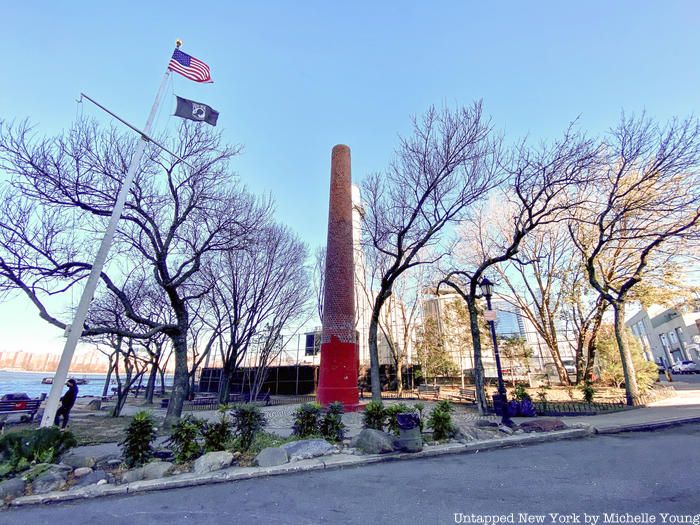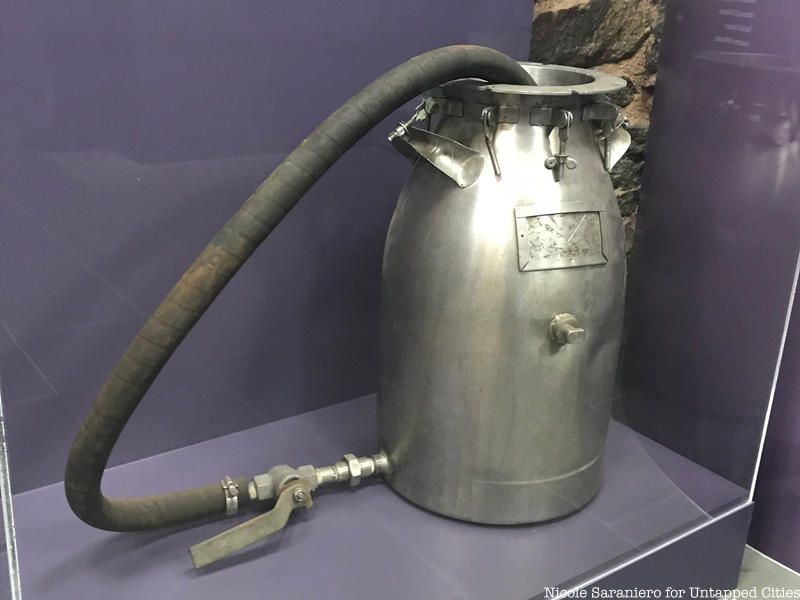Last-Minute NYC Holiday Gift Guide 🎁
We’ve created a holiday gift guide with presents for the intrepid New Yorker that should arrive just in time—


New York-based, pharmaceutical giant Pfizer has made headlines recently with the announcement of a COVID-19 vaccine shown to be more than 90% effective in trials. This latest breakthrough is one of many the company made since its founding in Brooklyn in 1849. More than 170 years ago, German-immigrants and cousins Charles Pfizer and Charles Erhart founded Charles Pfizer & Company in a brick building in Williamsburg. There, at the intersection of Harrison Avenue and Bartlett Street, they planted the roots of what would become one of the world’s largest producers of chemical products and pharmaceuticals.

The first successful product Pfizer made was a palatable santonin in the mid-1800s. Santonin was a drug used to treat intestinal worms, a common ailment people faced at the time due to a lack of food refrigeration. Customers preferred Pfizer’s santonin because it had an appealing almond-toffee taste rather than a bitter taste like its competitors. This debut product combined the talents of Pfizer, a chemist, and Erhart, a former confectioner. According to Miracle Medicines, the pair delivered their revolutionary remedy in wicker baskets by foot and later by horse and wagon.
In the 1860s, the outbreak of the Civil War greatly boosted the Pfizer company’s success. Products in the company’s inventory such as borax, camphor, and iodine were in high demand on the battlefield. To accommodate the immense need for medicinal products, the Pfizer company hired 150 new employees. In 1868, the company moved its headquarters to 81 Maiden Lane in Manhattan, but continued manufacturing in Brooklyn.

Using imported concentrates of lemon and lime, the company started to produce one of its most popular products, citric acid, in 1880. Just two years later, the first location outside of New York opened in Chicago. Citric acid is a popular additive in food and beverages, especially soft drinks like Coca-Cola. When World War I disrupted the company’s supply of citrus fruits from Europe, scientists had to figure out a new way to make their biggest seller. Food chemist James Currie decided to try making citric acid with fungus and mold, converting its sugar into citric acid. Currie mastered this fermentation process in 1919 and by the mid-1920s production of citric acid from sugar outpaced production from fruit so much that the price of citric acid dropped from $1.25 a pound to 20 cents. Experiments in fermentation continued and the process was applied to other products such as gluconic acid, a food preservative and cleanser, and ascorbic acid, Vitamin C. A smokestack from one of Pfizer’s molasses processing plants still stands in Grand Ferry Park in Brooklyn.
[post_featured_tour]
As Pfizer expanded in the late 19th-century, Brooklyn grew too. In a Sanborn Fire Insurance Map from 1893 you can see a nearby iron foundry, a candy factory, a theater, and residential development. At this point, the Pfizer chemical factory had expanded to buildings northwest of the original site. Those new buildings stood on the block bounded by Wallabout and Walton Streets, and Marcy Avenue.

A mid-20th-century penicillin storage container from Pfizer’s Bartlett Street lab
War proved a boon again for Pfizer in the 1940s. In 1941, the United States government put out a call for companies to expedite the production of penicillin to treat Allied soldiers. After penicillin was discovered by Alexander Fleming in 1928, he couldn’t figure out a way to mass-produce it. Pfizer’s deep-tank fermentation process gave the company an edge over the others racing to manufacture this “miracle drug.” The company purchased the Rubel Ice Plant on Marcy Avenue, near Pfizer’s growing Brooklyn lab compound, and turned it into a penicillin factory. The ice factory already had refrigeration equipment that would be needed, and the factory also made use of fourteen 7,500-gallon tanks. By the mid-1940s, Pfizer was the largest producer of penicillin in the world, churning out five times the expected amount. The Brooklyn Historical Society has in its collection a vat, dated to the mid-20th-century, that was used by the Pfizer company to store penicillin. Since deep-tank fermentation was so integral to the mass-production of the life-saving drug, the Marcy Avenue facility was designated as a National Historic Chemical Landmark by the American Chemical Society (ACS) in 2008.

The Pfizer company continued to grow and put out new chemical products throughout the rest of the 20th century. Terramycin® (oxytetracycline), a broad-spectrum antibiotic released in 1950 was the first pharmaceutical sold in the United States under the Pfizer label. In 1951, the company opened multiple locations worldwide including in Belgium, Brazil, Canada, Cuba and England. The company headquarters left Maiden Lane for midtown in 1961. In Brooklyn, the manufacturing plant continued to expand. In 1970 the company changed its name from Charles Pfizer & Company to just Pfizer Inc. and two years later hit more than a billion dollars in sales.
When most companies fled the blighted areas of Williamsburg in the 1970s, Pfizer kept its manufacturing operations on Flushing Avenue. The company was active in the local community, providing affordable housing and a charter school on company-owned property adjacent to the plant. From the late 20th-century and into the 2000s, Pfizer continued to produce landmark drugs including the blood pressure medication Lipitor, Viagra for erectile dysfunction, and Zoloft for depression.

Despite the skyrocketing success and steady growth of the company over the previous 150 plus years, global competition in the pharmaceutical industry and the rise of generic (cheaper) brands, finally forced Pfizer out of Brooklyn in 2007. By that time, the Pfizer compound had grown to occupy 660,000-square-feet at the site on Flushing Avenue. When the Brooklyn plant was forced to close, 600 people lost their jobs. A New York Times article from the time of its closure reported that the company planned to restore the original 1849 brick manufacturing building and turn it into the Charles Pfizer Community Education Center. It seems like those plans have since fallen through. On our visit to the site, there is nothing left of the building. An empty lot, which according to NYC Planning’s New York City’s Zoning & Land Use Map, is still owned by Pfizer, stands in its place.

Pfizer wanted to see its compound turned into a mixed-use, mixed-income complex but faced many challenges. At first, it proved difficult to find a buyer during the recession. Then, state assemblyman Vito Lopez tried to seize the property through eminent domain and turn it into affordable housing. The chemical company finally struck a deal with Acumen Capital in 2010. The developer has since transformed the Pfizer building into a local manufacturing hub, much like the one at the Brooklyn Navy Yard. Inside there are a variety of local businesses, including a distillery, cookie company, and other food production companies. In addition to light manufacturing, space inside the former chemical plant was also used as a counterterrorism training course by New York City’s Police Department, a soundproof recording studio for the Blue Man Group, and an area outside is used by the Trapeze School of New York. The complex is a popular filming location for television series and movies too.
The last piece of Pfizer property for sale in Brooklyn was purchased in 2017. In April 2018, Pfizer announced that it would be moving its headquarters from 219 and 235 East 42nd Street, to Hudson Yards. The company will lease fifteen floors within “The Spiral,” a twisting glass skyscraper designed by Bjarke Ingels and owned by Tishman Speyer at 66 Hudson Boulevard. The 42nd headquarters, which were sold to investor David Werner, will reportedly be demolished and replaced by one larger tower, a development allowed by the rezoning of East Midtown. While the chemical giant has locations all over the country and all over the world, Pfizer’s New York story is still unfolding.
Want to learn more about Williamsburg’s transformation from a gritty industrial neighborhood to hip artistic enclave? Join our Untapped New York Insiders for a virtual walkthrough with Untapped New York’s Cheif Experience Officer Justin Rivers! Not an Insider yet? Become a member today and get two months with code JOINUS. A video of the tour will also be made available to all our Insiders afterward in the Video Archive section of our website.
Next, check out Inside Brooklyn’s Former Pfizer Plant and Its Transformation into Manufacturing Hub
Subscribe to our newsletter